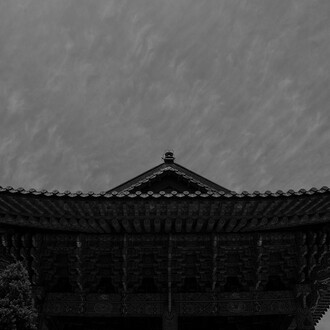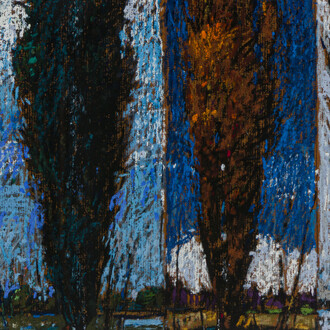Harkawik is pleased to announce The good life, our first exhibition with Polina Barskaya, opening at our Tribeca location this Friday, June 6, from 6-9pm.
Underneath the apse of The Cathedral of Saints Gervasius and Protasius, at the geographical center of Città della Pieve in Umbria, among perfunctory marble columns, some of Perugino’s finest frescoes not in Perugia, Deruta, Cerqueto, Montefalco or Panicale, a decidedly Shakespearean reliquary effigy and a few monstrances that might grace a John Carpenter film, is a first-rate crypt. The air is cool, and traces of Benozzo Gozzoli’s brush are visible where seven centuries of curious hands haven’t worn it away. Its battered stone pilliars remind me of beefy trans-siberian rail workers, huddling in a downpour; utterly confident in the unending and immovable fixedness of the value they hold to the world. I’m staring at the painter Polina Barskaya, who is surveying the place with happy wonder and curiosity as if she and her husband and their young daughter don’t come here all the time, given they live just a few blocks away. Barskaya has, this afternoon, finished the first of a dozen panels that will eventually comprise The good life.
It is not entirely clear to me at first from where this young family has stolen themselves. Barskaya was born in 1984 Cherkasy, Ukraine, and her partner, the actor and filmmaker Alexander Kaluzhsky, in Odessa, before his family landed in Brighton Beach. Both educated in New York, their daughter Maya is the only bona fide Italian, and only one in the making. They’ve chosen a life in Città della Pieve, away from the quickening pulse of the world, away from the the many and unyielding vexations and indignities that naturally follow, away from the rampant balkanization of our nations, away even from the progressive reclamation of civilization for wilderness by forces irreversible and indifferent. Away from that, at least, for now. More importantly, the path this family has cut through the world, and the one Barskaya has cut through the world of figurative painting, are one and the same. Barskaya’s life—her quiet, unplaceable moments, her sense of her own body and sexuality, her identity as the citizen of a particular place, her private family life, full of moments of tenderness and understanding—are the stuff of her paintings, and vice-versa.
Across the street from the cathedral is the town’s best and only cafe, apparently once called Caffè Fibonacci, and Polina and Alex remark warmly on how good the food is, and I wonder if this is the sort of thing they’ve convinced themselves of in the absence of a dizzying array of alternatives. No, in point of fact, the food is really very good. I linger a while in the bathroom, where a wheat-pasted handbill for a travel agent is as old to this cafe as the cathedral’s monstrances are to it (the phone number is comprised of a paltry three digits). It reads Paris non-stop and offers a charming illustration of what might be The Family Circus’ patriarch dining alfresco with an unfortunately dowdy Mona Lisa. In the background, the Eiffel Tower. That I should find this advert here, in a world apart from worlds, in the adopted home of these conscientious objectors, fills me with the sense that I’m pulling a thread meant to be pulled. Most of Barskaya’s paintings take place in hotel rooms, and their trappings, what they say about a region, a culture, a sense of place, are as much her subjects as the people who linger in them. They might be thought of as a kind of travelogue.
When I arrive at her studio, I’m greeted to a silhouetted view of the rolling hills of Umbria, and to another one on an easel. There’s a profoundly uncanny effect to seeing these paintings that make such effective use of windows, framing devices, and lush landscapes that peek in on their setting, in this place, where the setting is right in front of us. It seems as if Barskaya has created this life as an illustration of the paintings themselves, not the other way around. The light streaming through these windows seems to be borrowed from Degas, the vibrating black lines that outline her subjects from Neel. I know that since this early visit, she and her family have been to Dublin, to Florence, to Bologna, to Turin. The paintings that have emerged are a broad and accomplished elaboration on the territory Barskaya has claimed for her own. They fool you easily, reproduce poorly, and generally unfold like a fascinating study in micro-dynamics; most fully, perhaps, in the stately black Casa Howard Florence. Here Alexander sips from one of Europe’s ubiquitous squat bar glasses, his towel and slippers proclaiming to us the divine providence of his place in the room. Maya holds toast like the heir to a byzantine empire, and the painter looks beyond billowing curtains, her expression complexity itself. She is caustic, hopeful, implacable, gentle, confident and childlike all together. Like most of these paintings, the real center of attention is a piece of furniture (in this case, a hassock, brimming with personality).
There’s a way that states of undress are invariably conflated with the erotic, and in Barskaya’s paintings, this nuance is crucial. Even still, some of the more clinical nudes of her prior self-portraiture, that might be thought of as body-checking, that might have recalled the conflicted sexualities of Elfriede Jelinek, Chantal Akerman or Catherine Breillat, are absent here. It occurs to me that this kind of vulnerability, the fluid movement between the dual roles of author and subject, might have been explored most fully to date in the medium of photography, and to the extent that we can consider all contemporary representational paintings as constructed images, a kind of lineage comes to mind: Hannah Wilke, Francesca Woodman, Peggy Nolan, Sally Mann, Leigh Ledare, Melissa Shook. By concentrating on group settings and situating her subjects in sleeping poses (more than half of these compositions are dominated by a bed), Barskaya shows nothing about the body that we can’t find in our own; comfort, security, tenderness, an awkwardness normalized by daily use and familiarity. This is a kind of extreme anti-objectification.
There’s a way that the furnishings of Barskaya’s adopted homes tend to lose their sense of gravity and proportion as their proximity nears our own. In the languid Madonella agricola, a loudly upholstered squab bulges in the crevice between an armchair’s cushions, sinking into a cobalt throw even as its embroidery suggests it might cartwheel forward like a tire. The painter looks at us, head cocked in an act of gentle defiance, as if we want something from her that’s not in the offing, or else to foreclose the possibility of an encounter altogether. Floral room is a magnificent portrait of petulance. Maya sits on a divan and marshals the psychic energy of the room, gathering around her a nearby bedspread, just as the florid pink branches of the room’s wallpaper seem to reorient themselves around her also, like an indoor lightning storm conjured by her mood. In Alex and Maya, two Pepto-Bismol pink chairs are so exaggerated that they have become unfixed masses, pushing us out of the picture. It is no accident that here, Maya wears an Exorcist stare, her figure illuminated as if by the flash of a camera.
It occurs to me, finally, that the world Barskaya has created here might be one she can inhabit more fully, one in which the viewer might unpack, or at least witness, the web of emotions that we encounter each day, those that have no obvious outlet or resolution. The exhibition’s two unabashedly lovely paintings, Dublin morning light, and Bologna, both stamped with a kind of rich saturated light that might leech the colors from the cover of a book left in the sun, are another misapprehension; Maya’s expression is fully of uncanny worldliness, and the inclusion of a painting-within-painting, a forgettable still life above the bed, feels like a kind of self-critique. I’ve entered fully, willingly, complicitly into Barskaya’s conflicted and beguiling array of homes-away-from-homes. Into The Good Life.
(Text by Peter Harkawik)
















